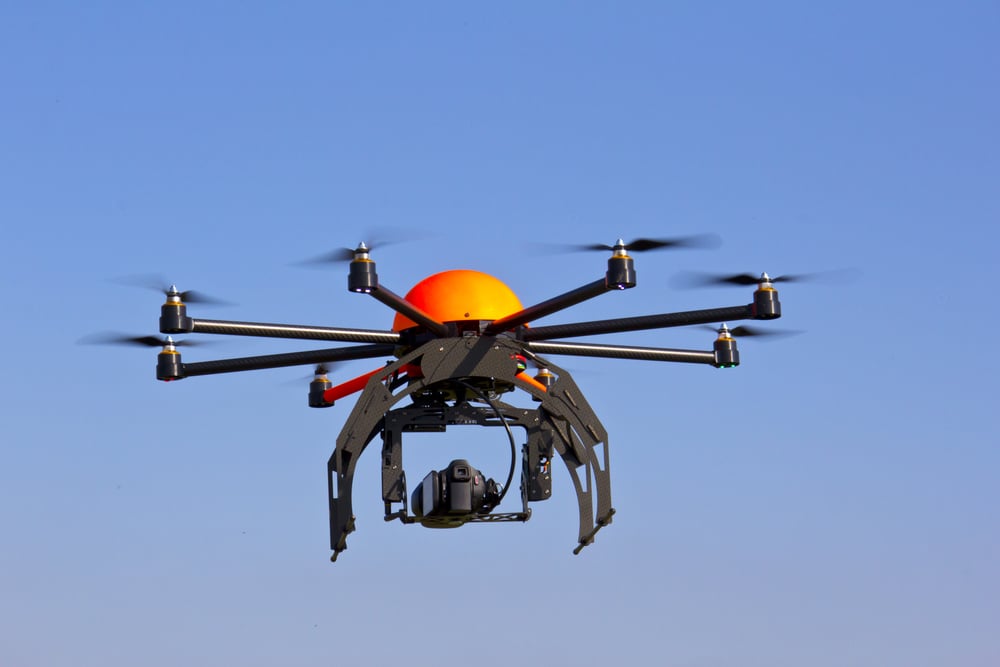Drones, also known as unmanned aerial vehicles or unmanned aerial systems, can be equipped with cameras, thermal scanners, license plate readers and facial-recognition software.
Able to accomplish feats that manned aircraft and even traditional remote-controlled airplanes cannot, they can get within close proximity of a person or property, unnoticed, and take audio-video recordings and photographs.
They can also provide streaming video to an audience over a small personal device like a smartphone. Given their technology and capabilities, drones allow for new forms of privacy invasion.
Drones have become increasingly popular as the technology has advanced and prices have gone down. The Federal Aviation Administration estimated that at least 1.6 million drones were sold in 2015.
Commercial and private aircraft flying legally over private property in the navigable airspace established by the FAA have always enjoyed freedom from claims of invasion of privacy.
However, drones can operate in extremely confined spaces at low altitudes, and the FAA has limited their recreational use to an altitude below 400 feet. Drones flying over a person or backyard would be lower than 400 feet, creating conditions for a forthcoming storm of invasion-of-privacy claims arising out of drone surveillance.
|Common-law invasion of privacy
There are two forms of common law invasion of privacy: Intrusion upon seclusion and publication of private facts.
1. Intrusion upon seclusion
A leading treatise defines intrusion upon seclusion as a tort in which one "intentionally intrudes, physically or otherwise, upon the solitude or seclusion of another or his private affairs or concerns, is subject to liability to the other for invasion of his privacy, if the intrusion would be highly offensive to a reasonable person." Intrusion upon seclusion must be intentional; there is no such tort as negligent intrusion upon seclusion.
Intrusion on seclusion means intrusion into a private space. Observation of a person in public generally does not amount to liability for intrusion upon seclusion. For example, using a drone to hover outside someone's home while using the drone's mounted camera to peer into a window without that person's permission could subject the drone operator to liability for common-law intrusion upon seclusion.
2. Publication of private facts
The second form of common-law invasion of privacy is publication of private facts. The elements of this tort are the publication of private facts that are offensive and are of no public concern. The tort addresses the public dissemination of private information rather than the mere gathering of the information itself. Accordingly, a person who gathers the private information, but then does not publicly disseminate it, is not liable for this tort. Disseminating the private facts presupposes intent by the actor.
|States taking action
Many states have passed laws directed at drones in light of growing invasion-of-privacy concerns.
States such as Florida, Idaho, North Carolina, Oregon, Tennessee and Texas have passed laws that address the use of drones by private parties. For instance, Florida's Freedom from Unwarranted Surveillance Act prohibits the use of a drone "to record an image of privately owned real property or of the owner, tenant, occupant, invitee or licensee of such property with the intent to conduct surveillance on the individual or property captured in the image in violation of such person's reasonable expectation of privacy without his or her written consent."
Under the statute, "a person is presumed to have a reasonable expectation of privacy on his or her privately owned real property if he or she is not observable by persons located at ground level in a place where they have a legal right to be, regardless of whether he or she is observable from the air with the use of a drone." The prevailing plaintiff is entitled to compensatory damages and injunctive relief to prevent future violations against the offender, plus reasonable attorney's fees. A fee multiplier is not allowed unless the case is tried to a verdict, in which case a multiplier of up to twice the actual value of the time expended may be awarded. Punitive damages may also be awarded subject to other requirements and limitations under the law.
Some states have had stalking statutes in place for years. California, for example, passed a stalking statute a few years ago to deal, in particular, with paparazzi stalking celebrities. Stalking statutes create a private cause of action against anyone who engages in a pattern of conduct with the intent to follow, alarm, place under surveillance or harass the plaintiff, and which causes fear for safety or emotional distress. A drone can follow and hover over someone and cause considerable emotional alarm. Many news stories have reported on these types of incidents. The courts would almost certainly be willing to permit a victim of drone-stalking to pursue a civil action under state civil-stalking statutes.
|Insurance policies and privacy-invading drones
As privacy-tort claims against drone-operating policyholders begin to materialize, insurers need to be ready to make coverage determinations. The type of insurance policy issued to the drone operator may determine whether the policy will potentially cover the claim. A typical homeowners policy and a commercial general liability policy would, more than likely, not cover an insured who used a drone to violate someone's privacy, as explained below.
Related: 10 risks and misuses for drones

Some policies may cover property damage, but not invasion of privacy claims. (Photo: Shutterstock)
|Homeowner policies
Coverage E under a typical homeowners policy provides comprehensive personal liability coverage.
This type of coverage protects the insured against claims arising out of accidents that cause injuries or damage to others on property the insured owns or rents. A homeowners policy also follows the insured wherever he or she goes in the coverage territory, unless the accident involves an automobile, boat or aircraft (that is, an auto, boat or aircraft exclusion may apply). Coverage E applies only to accidents, though. The insuring language requires an accident that caused the injury or damage. In addition, Coverage E usually has an intentional-or-expected injury exclusion. A standard homeowner's policy does not cover personal injury claims that may include invasion of privacy.
If a homeowner uses a drone to spy on her neighbor and the neighbor sues, there may not be coverage under the homeowners policy for a few reasons. First, there is no such as thing as negligent intrusion upon seclusion, as discussed above, so the insuring clause language may not be met. Second, an intentional-or-expected injury exclusion may apply, assuming the insuring language is even met. Third, an aircraft exclusion may also apply, depending upon how the policy defines "aircraft."
|CGL policies
All kinds of businesses purchase commercial general liability policies. The guiding principle behind general liability insurance is that it does not cover intended or expected injuries. Along those lines, the insuring language under Coverage A requires an accident that causes injury or damage.
A small-business owner who spies on an individual could cause her "bodily injury." Some commercial general liability policies under Coverage A define "bodily injury" to include mental anguish, mental injury, shock and fright. Although the definition of "bodily injury" may be met, an invasion-of-privacy tort requires intent. Thus, the insuring language that requires an accident will not be met. Coverage A typically also has an expected-or-intentional injury exclusion that will be triggered. Coverage A under a commercial general liability policy would therefore probably not respond to an invasion-of-privacy claim because of its intentional nature.
Coverage B under a commercial general liability policy covers "personal and advertising injury," so the drone operator facing an invasion-of-privacy claim should look under that coverage part for potential coverage. Coverage B's insuring clause typically provides that the insurer "will pay those sums that the insured becomes legally obligated to pay as damages because of 'personal and advertising injury' to which this insurance applies." The typical policy defines "personal and advertising injury" as "injury, including consequential 'bodily injury,' arising out of … Oral or written publication, in any manner, of material that violates a person's right of privacy." Thus, if a lawsuit alleges a violation of the right of privacy, a commercial general liability policy's Coverage B may be implicated.
The "Knowing Violation of Rights of Another" exclusion in Coverage B may likely apply, however. The exclusion precludes advertising injury caused by or at the direction of the insured with the knowledge that the act would violate the rights of another and would inflict "personal and advertising injury." This exclusion may therefore preclude coverage under Coverage B for a drone invading someone's privacy.
While drones are relatively new, invasion-of-privacy claims are not. Drones simply provide a new vehicle for voyeurs and other ill-intentioned actors to invade a person's privacy.
As drone technology continues to advance, it will allow people to invade someone's privacy with more ease, so inevitably, more people will do it.
Tort law and insurance coverage issues surrounding drones may not be so different than cases involving a different and more traditional vehicle or instrument such as an automobile, model airplane and the like. Most tort laws protect against negligence and so liability policies cover negligence claims. However, invasion-of-privacy claims are intentional in nature and typical liability insurance will not cover them.
James Michael Shaw Jr., J.D., and Ryan K. Hilton, J.D., are partners and co-chairs of the aviation practice group at Butler Weihmuller Katz Craig LLP in Tampa, Florida.
Want to continue reading?
Become a Free PropertyCasualty360 Digital Reader
Your access to unlimited PropertyCasualty360 content isn’t changing.
Once you are an ALM digital member, you’ll receive:
- Breaking insurance news and analysis, on-site and via our newsletters and custom alerts
- Weekly Insurance Speak podcast featuring exclusive interviews with industry leaders
- Educational webcasts, white papers, and ebooks from industry thought leaders
- Critical converage of the employee benefits and financial advisory markets on our other ALM sites, BenefitsPRO and ThinkAdvisor
Already have an account? Sign In Now
© 2024 ALM Global, LLC, All Rights Reserved. Request academic re-use from www.copyright.com. All other uses, submit a request to [email protected]. For more information visit Asset & Logo Licensing.








